Design and Realization of a Hybrid Excited Flux Switching Vernier Machine for Renewable Energy Conversion
Abstract
:1. Introduction
2. Structure and Electromagnetic Design of Studied Machine
3. Performance Analysis
4. Prototype Construction
5. Experimental Study
6. Conclusions
Author Contributions
Funding
Data Availability Statement
Conflicts of Interest
References
- ADEME. Vers un Mix Électrique 100% Renouvelable en 2050; Rapport Final. 2015. Available online: https://librairie.ademe.fr/recherche-et-innovation/2639-a-100-renewable-electricity-mix-analyses-and-optimisations.html (accessed on 22 September 2021).
- ENEA Consulting. Les Énergies Marines Renouvelables. Enjeux et Solutions Techniques, Mai 2012. Available online: https://www.enea-consulting.com/static/adc8934d020870e98b7823b4f3e61219/enea-les-energies-marines-renouvelables.pdf (accessed on 22 September 2021).
- Ministère de la Transition Écologique, Énergies Marines Renouvelables. Available online: https://www.ecologique-solidaire.gouv.fr/energies-marines-renouvelables-0 (accessed on 22 September 2021).
- Xie, S.J.; Xu, Z. Multitooth Magnetic Bridge Type Hybrid Excitation Magnetic Flux Switching Motor. Chinese Patent CN101834474 (A), 15 September 2010. [Google Scholar]
- Hoang, E.; Lécrivain, M.; Gabsi, M. A new structure of a switching flux synchronous polyphased machine with hybrid excitation. In Proceedings of the 2007 European Conference on Power Electronics and Applications, Aalborg, Denmark, 2–5 September 2007. [Google Scholar]
- Sulaimana, E.; Ahmada, M.Z.; Kosakab, T.; Matsui, N. Design optimization studies on high torque and high power density hybrid excitation flux switching motor for HEV. Procedia Eng. 2013, 53, 312–322. [Google Scholar] [CrossRef] [Green Version]
- Gaussens, B.; Hoang, E.; Lécrivain, M.; Manfe, P.; Gabsi, M. A Hybrid-excited flux-switching machine for high-speed DC-alternator applications. IEEE Trans. Ind. Electron. 2014, 61, 2976–2989. [Google Scholar] [CrossRef] [Green Version]
- Zhu, Z.Q.; Chen, J.T.; Pang, Y.; Howe, D.; Iwasaki, S.; Deodhar, R. Analysis of a novel multi-tooth flux-switching PM brushless AC machine for high torque direct-drive applications. IEEE Trans. Magn. 2008, 44, 4313–4316. [Google Scholar] [CrossRef]
- Chen, J.T.; Zhu, Z.Q.; Howe, D. Stator and rotor pole Combinations for multi-tooth flux-switching permanent-magnet brushless AC machines. IEEE Trans. Magn. 2008, 44, 4659–4667. [Google Scholar] [CrossRef]
- Wu, Z.; Zhu, Z.Q.; Hua, W.; Akehurst, S.; Zhu, X.; Zhang, W.; Hu, J.; Li, H.; Zhu, J. Analysis and suppression of induced voltage pulsation in DC winding of five-phase wound-field switched flux machines. IEEE Trans. Energy Convers. 2019, 34, 1890–1905. [Google Scholar] [CrossRef]
- Wu, Z.Z.; Zhu, Z.Q.; Wang, C.; Mipo, J.C.; Personnaz, S.; Farah, P. Reduction of open-circuit DC-winding-induced voltage in wound field switched flux machines by skewing. IEEE Trans. Ind. Electron. 2019, 66, 1715–1726. [Google Scholar] [CrossRef] [Green Version]
- Sun, X.; Zhu, Z.Q. Investigation of DC winding induced voltage in hybrid-excited switched-flux permanent magnet machine. IEEE Trans. Ind. Appl. 2020, 56, 3594–3603. [Google Scholar] [CrossRef]
- Sun, X.Y.; Zhu, Z.Q.; Wei, F.R. Voltage pulsation induced in DC field winding of different hybrid excitation switched flux machines. In Proceedings of the EEEE Energy Conversion Congress and Exposition (ECCE 2020), Detroit, MI, USA, 11–15 October 2020; pp. 1–8. [Google Scholar]
- Sun, X.Y.; Zhu, Z.Q.; Cai, S.; Wang, L.; Wei, F.R.; Shao, B. Influence of stator slot and rotor pole number combination on field winding induced voltage ripple in hybrid excitation switched flux machine. IEEE Trans. Energy Convers. 2021, 36, 1245–1261. [Google Scholar] [CrossRef]
- Tiegna, H. Contribution à la Modélisation Analytique des Machines Synchrones à Flux Axial à Aimants Permanents à Attaque Directe en vue de leur Dimensionnement. Application aux Éoliennes. Ph.D. Thesis, Université du Havre, Le Havre, France, 2013. [Google Scholar]
- Lee, C.H. Vernier motor and its design. IEEE Trans. Power Appar. Syst. 1963, 82, 343–349. [Google Scholar] [CrossRef]
- Rhodes, D.J. Assessment of Vernier motor design using generalised machine concepts. IEEE Trans. Power Appar. Syst. 1977, 96, 1346–1352. [Google Scholar] [CrossRef]
- Chau, K.T.; Li, Y.B.; Jiang, J.Z.; Niu, S. Design and control of a PM brushless hybrid generator for wind power application. IEEE Trans. Magn. 2006, 42, 3497–3499. [Google Scholar] [CrossRef] [Green Version]
- Liu, C.; Chau, K.T.; Jiang, J.Z.; Jian, L. Design of a new outer-rotor permanent magnet hybrid machine for wind power generation. IEEE Trans. Magn. 2008, 44, 1494–1497. [Google Scholar]
- Tiegna, H.; Amara, Y.; Barakat, G.; Dakyo, B. Overview of high power wind turbine generators. In Proceedings of the International Conference on Renewable Energy Research and Applications (ICRERA2012), Nagasaki, Japan, 11–14 November 2012; pp. 1–6. [Google Scholar]
- McDonald, A.S. Hybrid Excitation of Synchronous Generators for Wind Turbines. In Proceedings of the 2nd IET Renewable Power Generation Conference (RPG2013), Beihang University (BUAA), Beijing, China, 9–11 September 2013. [Google Scholar]
- Amuhaya, L.L.; Kamper, M.J. Design and optimisation of grid compliant variable-flux PM synchronous generator for wind turbine applications. In Proceedings of the IEEE Energy Conversion Congress and Exposition (ECCE 2015), Montreal, QC, Canada, 20–24 September 2015; pp. 1–8. [Google Scholar]
- Ployard, M.; Gillon, F.; Ammar, A.; Laloy, D.; Vido, L. Hybrid excitation topologies of synchronous generator for direct drive wind turbine. In Proceedings of the IEEE Energy Conversion Congress and Exposition (ECCE 2016), Milwaukee, WI, USA, 18–22 September 2016; pp. 1–7. [Google Scholar]
- Wang, Q.; Niu, S. Overview of flux-controllable machines: Electrically excited machines, hybrid excited machines and memory machines. Renew. Sustain. Energy Rev. 2017, 68, 475–491. [Google Scholar] [CrossRef]
- Ching, T.W.; Chau, K.T.; Li, W. Power factor improvement of a linear Vernier permanent-magnet machine using auxiliary DC field excitation. IEEE Trans. Magn. 2016, 52, vg8204804. [Google Scholar] [CrossRef]
- Beik, O.; Schofield, N. High-voltage hybrid generator and conversion system for wind turbine applications. IEEE Trans. Ind. Electron. 2018, 65, 3220–3229. [Google Scholar] [CrossRef] [Green Version]
- Zhao, X.; Niu, S.; Fu, W. Sensitivity analysis and design optimization of a new hybrid-excited dual-PM generator with relieving-DC-saturation structure for stand-alone wind power generation. IEEE Trans. Magn. 2020, 56, 7504105. [Google Scholar] [CrossRef]
- Available online: https://greah.univ-lehavre.fr/spip.php?article215 (accessed on 22 September 2021).
- Hlioui, S.; Gabsi, M.; Ben Ahmed, H.; Barakat, G.; Amara, Y.; Chabour, F.; Paulides, J.J.H. Hybrid excited synchronous machines. IEEE Trans. Magn. 2021. [Google Scholar] [CrossRef]
- CEDRAT. User Guide Flux® 11.2. New Features. 2013. Available online: http://www.tianyuantech.com/download/flux112.pdf (accessed on 22 September 2021).
- Atallah, K.; Howe, D.; Mellor, P.H.; Stone, D.A. Rotor loss in permanent-magnet brushless AC machines. IEEE Trans. Ind. Appl. 2000, 36, 1612–1618. [Google Scholar]
- Frias, A.; Kedous-Lebouc, A.; Chillet, C.; Albert, L.; Calegari, L.; Messal, O. Loss minimization of an electrical vehicle machine considering its control and iron losses. IEEE Trans. Magn. 2016, 52, 8102904. [Google Scholar] [CrossRef]
- Ede, J.D.; Atallah, K.; Jewell, G.W.; Wang, J.B.; Howe, D. Effect of axial segmentation of permanent magnets on rotor loss in modular permanent-magnet brushless machines. IEEE Trans. Ind. Appl. 2007, 43, 1207–1213. [Google Scholar] [CrossRef]
- Nair, S.S.; Wang, J.; Chin, R.; Chen, L.; Sun, T. Analytical prediction of 3-D magnet eddy current losses in surface mounted PM machines accounting slotting effect. IEEE Trans. Energy Convers. 2017, 32, 414–423. [Google Scholar] [CrossRef]
- Leroy-Somer (Nidec). Manuel de l’Électromécanique. Available online: https://www.leroy-somer.com/documentation_pdf/5181_fr.pdf (accessed on 22 September 2021).
- HBM. T40B: Mesure de Couple de 50 Nm à 10k Nm. Available online: https://www.hbm.com/fr/3004/t40b-torque-transducer-with-a-rotational-speed-measuring-system/ (accessed on 22 September 2021).
- Nedjar, B.; Hlioui, S.; Amara, Y.; Vido, L.; Gabsi, M.; Lécrivain, M. A new parallel double excitation synchronous machine. IEEE Trans. Magn. 2011, 47, 2252–2260. [Google Scholar] [CrossRef]
- Yamazaki, K.; Nishioka, K.; Shima, K.; Fukami, T.; Shirai, K. Estimation of assist efffects by additional permanent magnets in salient-pole synchronous generators. IEEE Trans. Ind. Electron. 2012, 59, 2515–2523. [Google Scholar] [CrossRef]
- Kamiev, K.; Nerg, J.; Pyrhönen, J.; Zaboin, V.; Hrabovcova, V.; Rafajdus, P. Hybrid excitation synchronous generators for island operation. IET Electr. Power Appl. 2012, 6, 1–11. [Google Scholar] [CrossRef]
- Kamiev, K.; Pyrhönen, J.; Nerg, J.; Zaboin, V.; Tapia, J. Modeling and testing of an armature-reaction-compensated (PM) synchronous generator. IEEE Trans. Energy Convers. 2013, 28, 849–859. [Google Scholar] [CrossRef]
- Kamiev, K. Design and Testing of Armature-Reaction Compensated Permanent Magnet Synchronous Generator for Island Operation. Ph.D. Thesis, Lappeenranta University of Technology, Lappeenranta, Finland, 2013. [Google Scholar]
- Kamiev, K.; Nerg, J.; Pyrhönen, J.; Zaboin, V.; Tapia, J. Feasibility of an armature-reaction-compensated permanent-magnet synchronous generator in island operation. IEEE Trans. Ind. Electron. 2014, 61, 5057–5058. [Google Scholar] [CrossRef] [Green Version]
- Kamiev, K.; Parviainen, A.; Pyrhönen, J. Hybrid excitation synchronous generators for small hydropower plants. In Proceedings of the 22nd International Conference Electrical Machines (ICEM 2016), Lausanne, Switzerland, 4–7 September 2016. [Google Scholar]
- Ammar, A.; Berbecea, A.C.; Gillon, F.; Brochet, P. Influence of the ratio of hybridization on the performances of synchronous generator with hybrid excitation. In Proceedings of the 20th International Conference on Electrical Machines (ICEM 2012), Marseille, France, 2–5 September 2012. [Google Scholar]
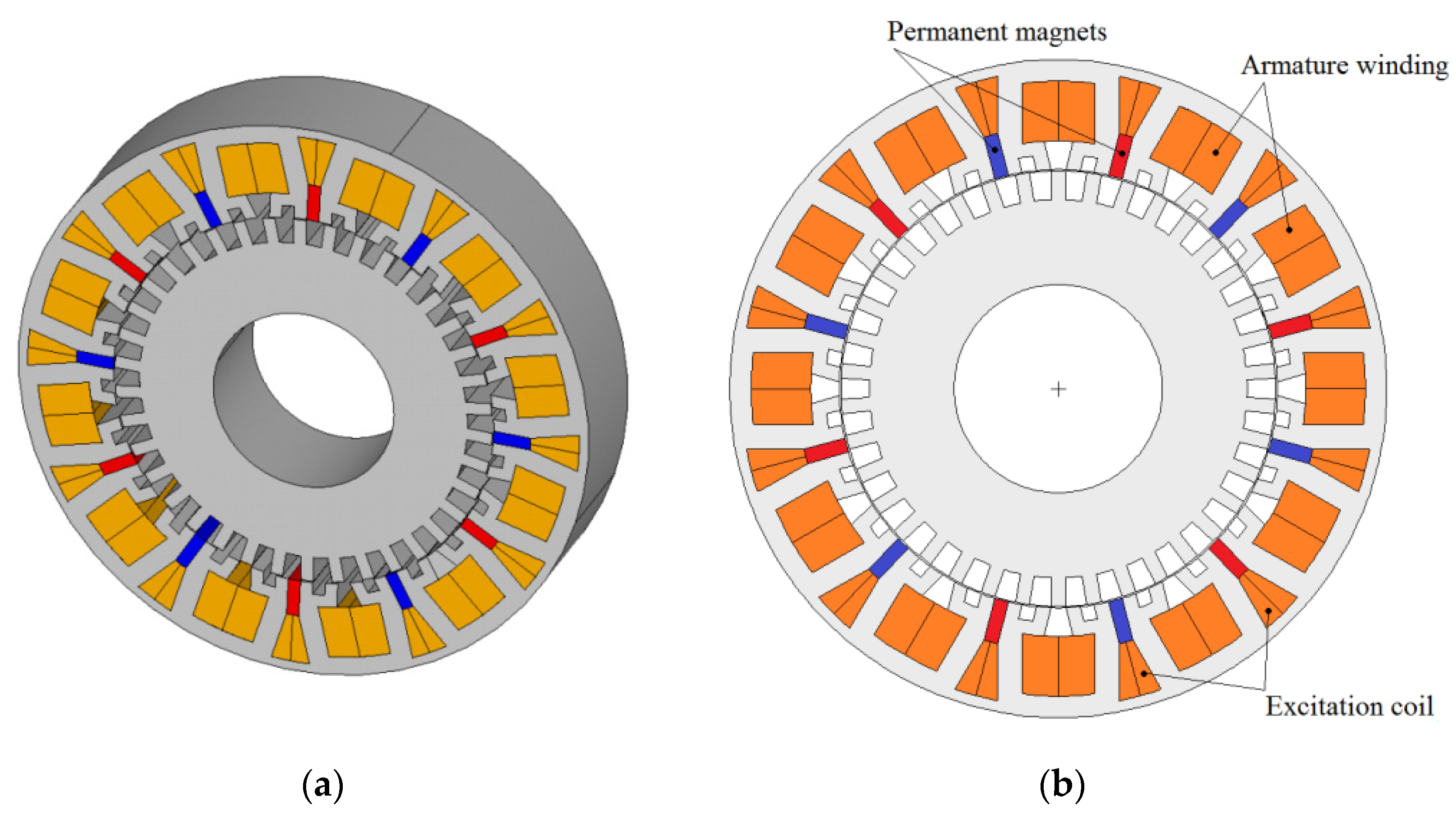
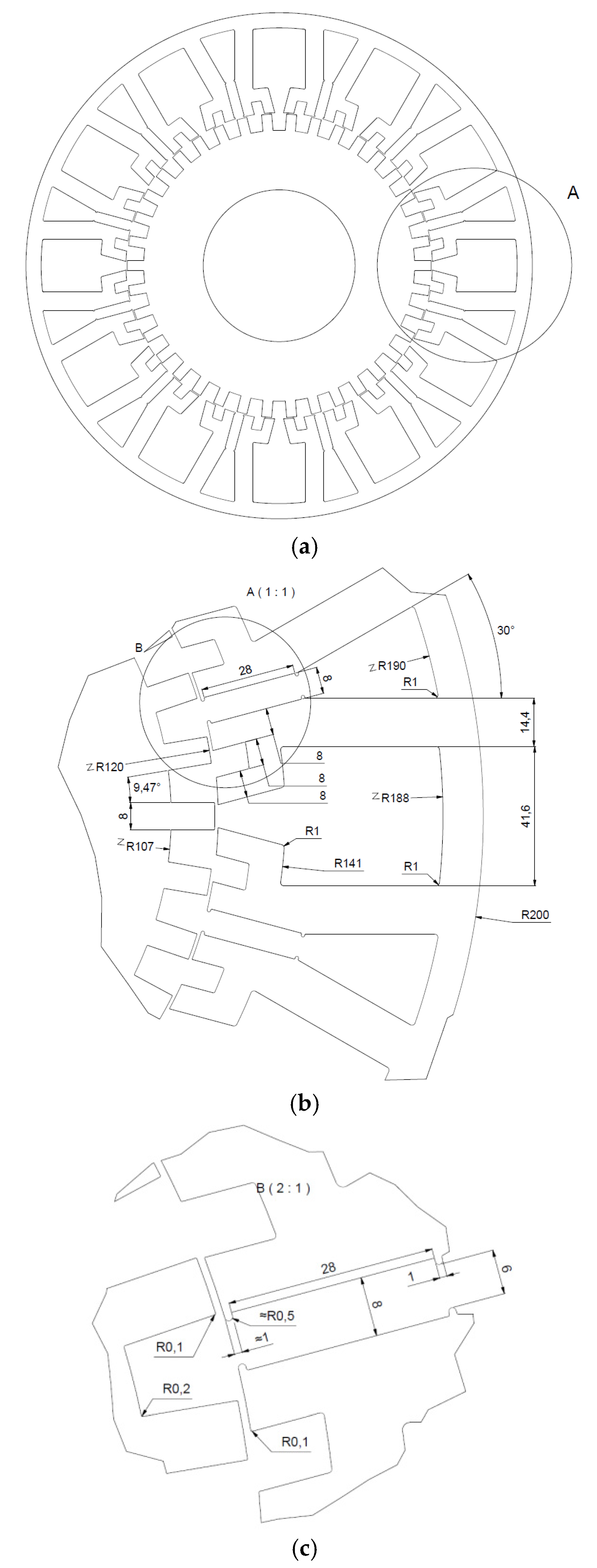
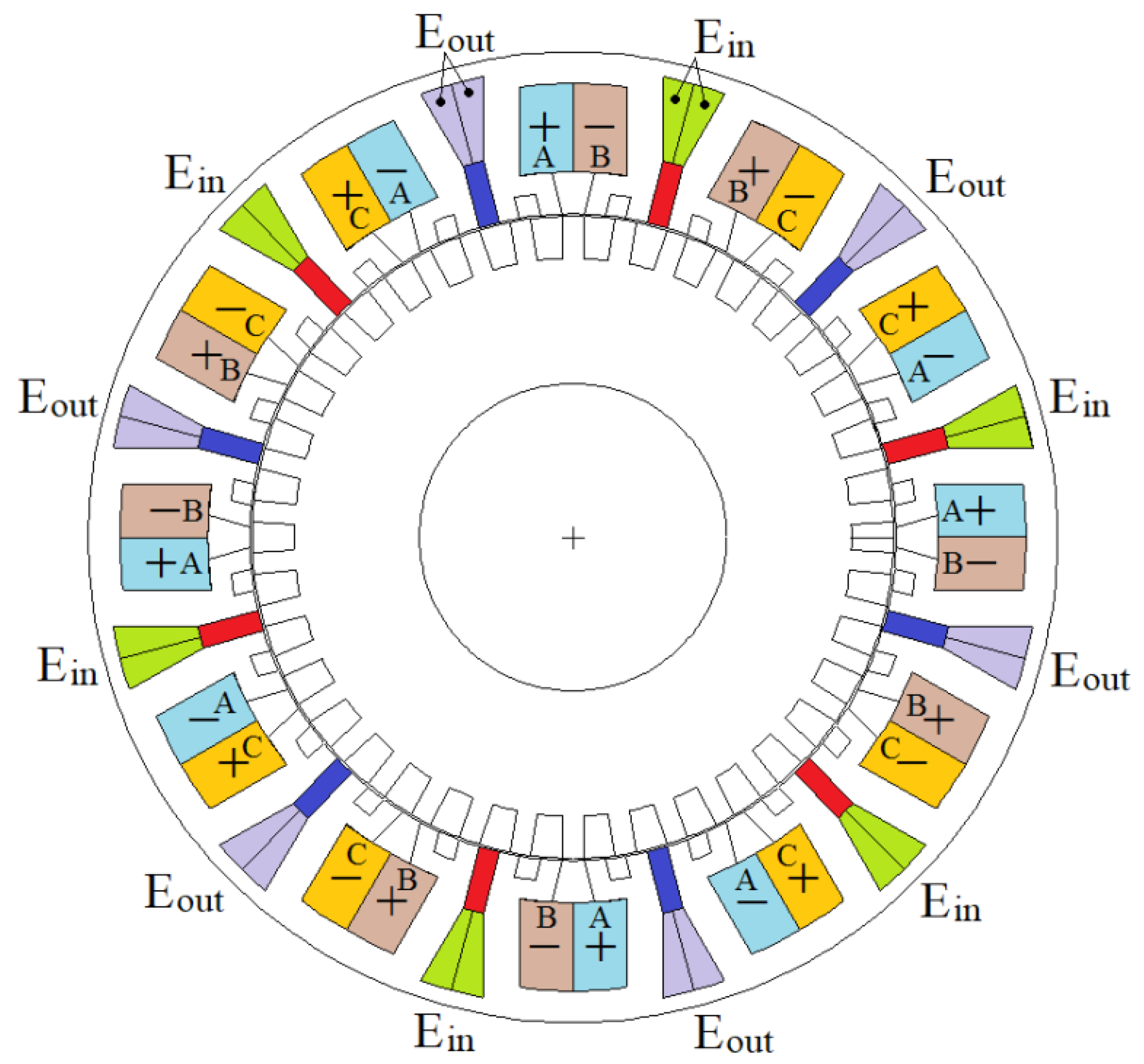
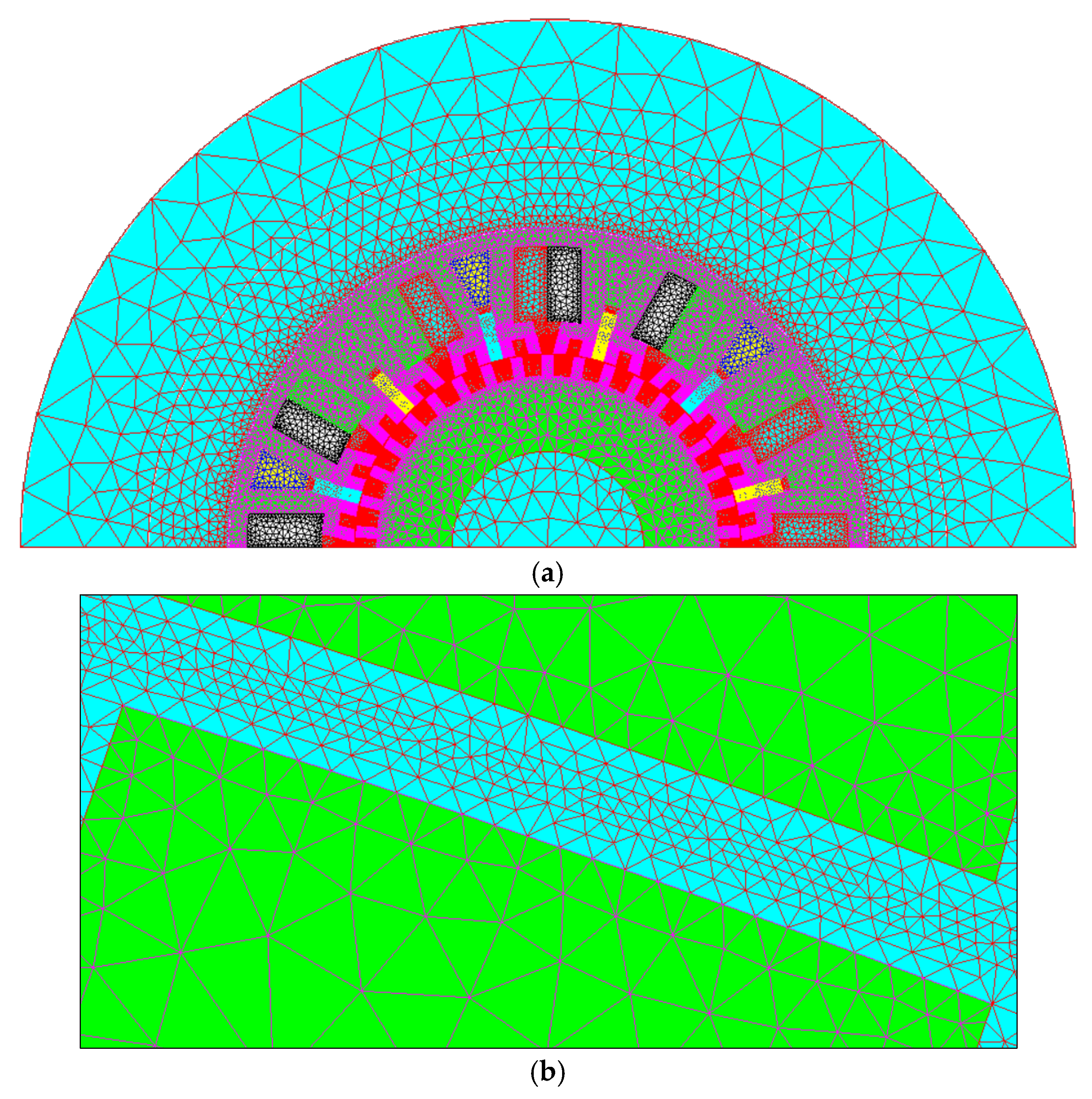
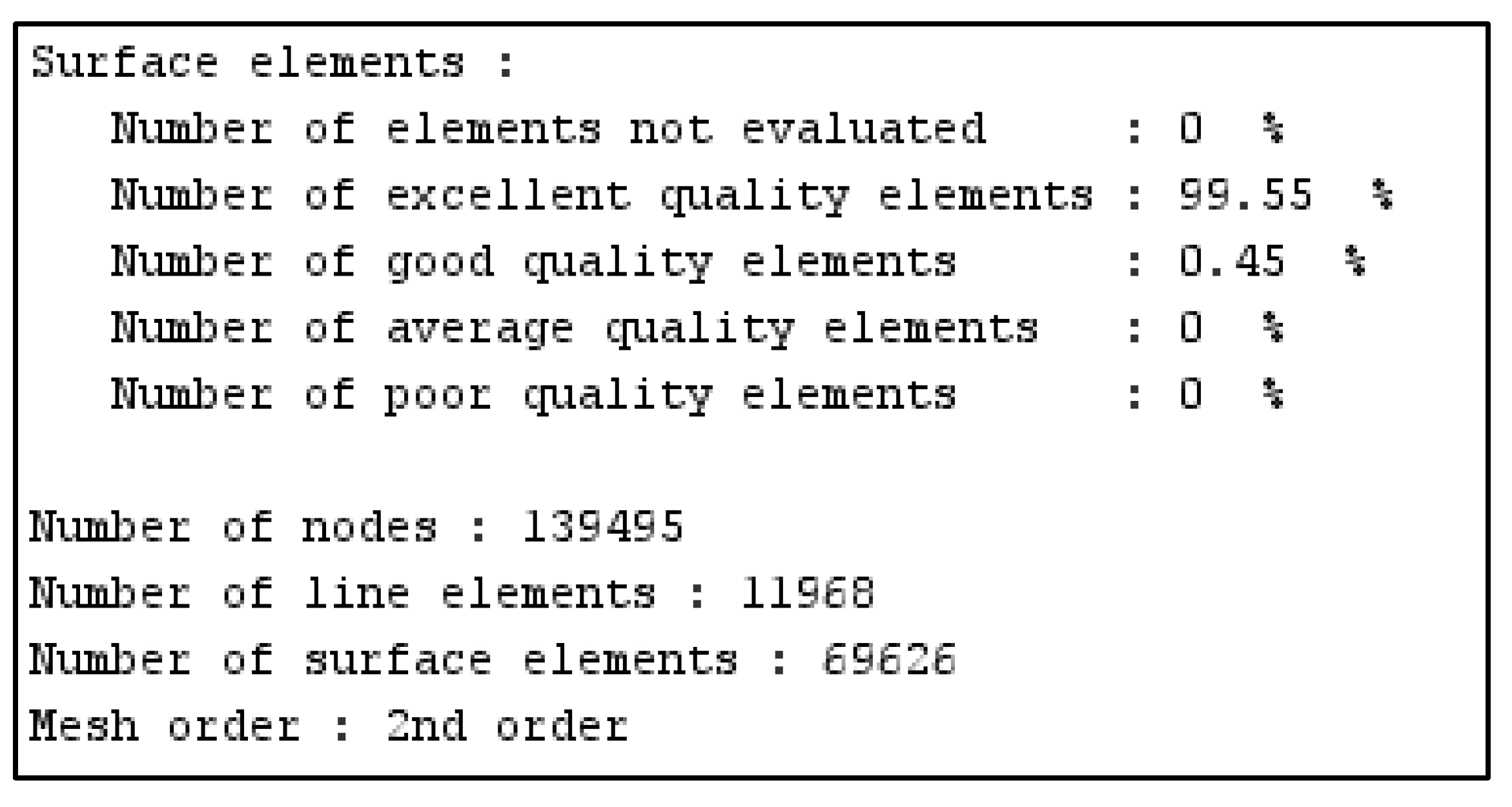
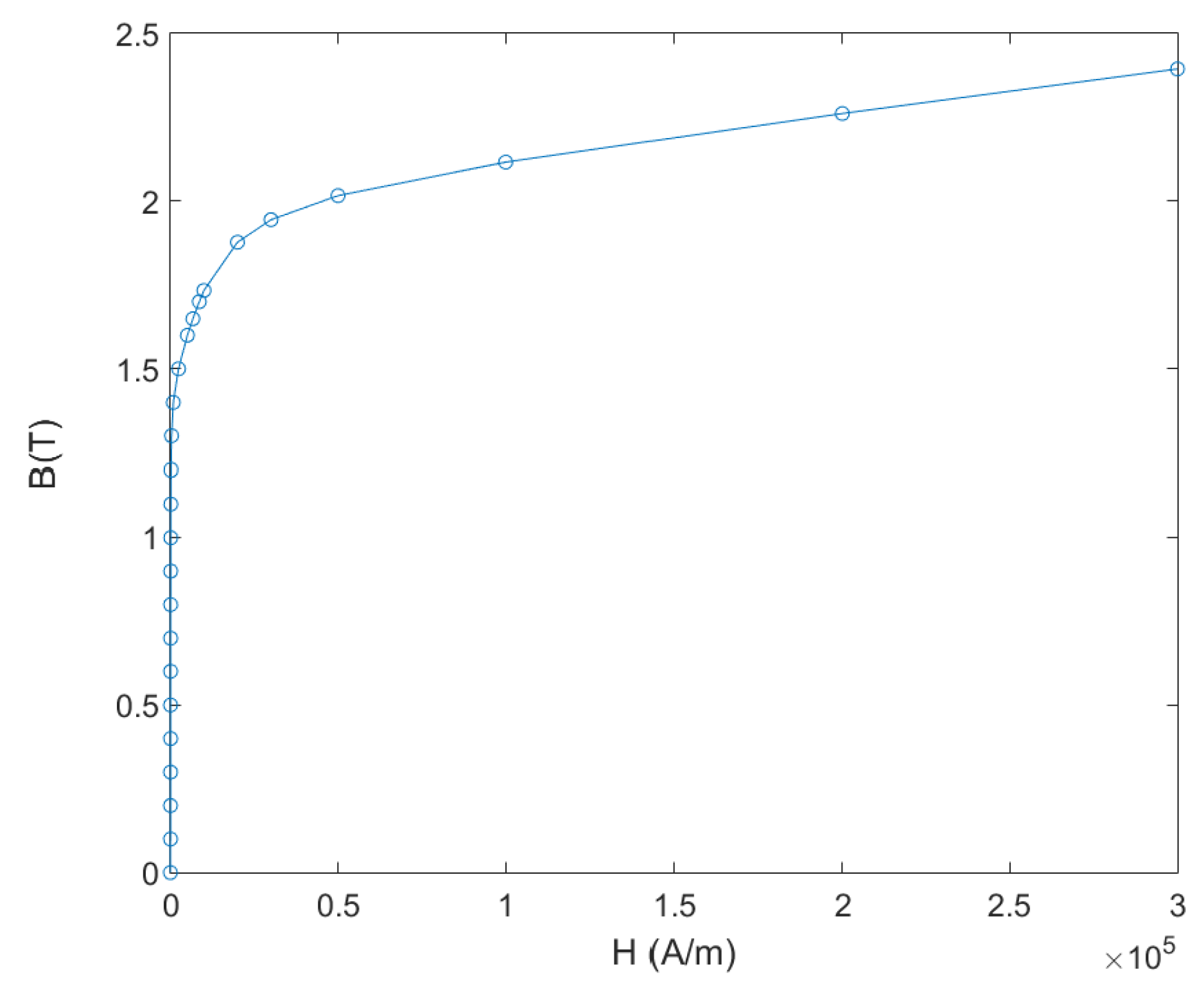
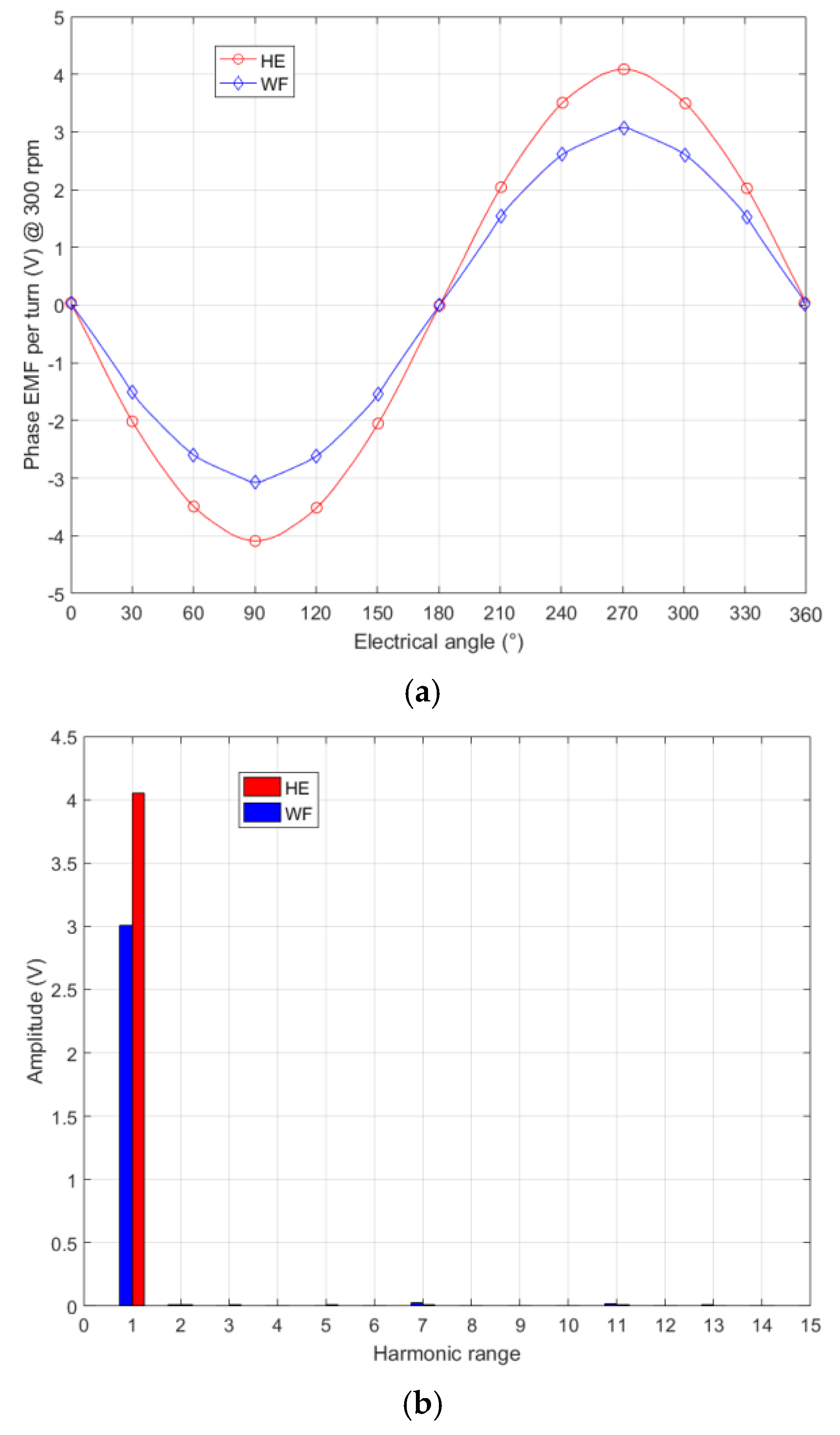
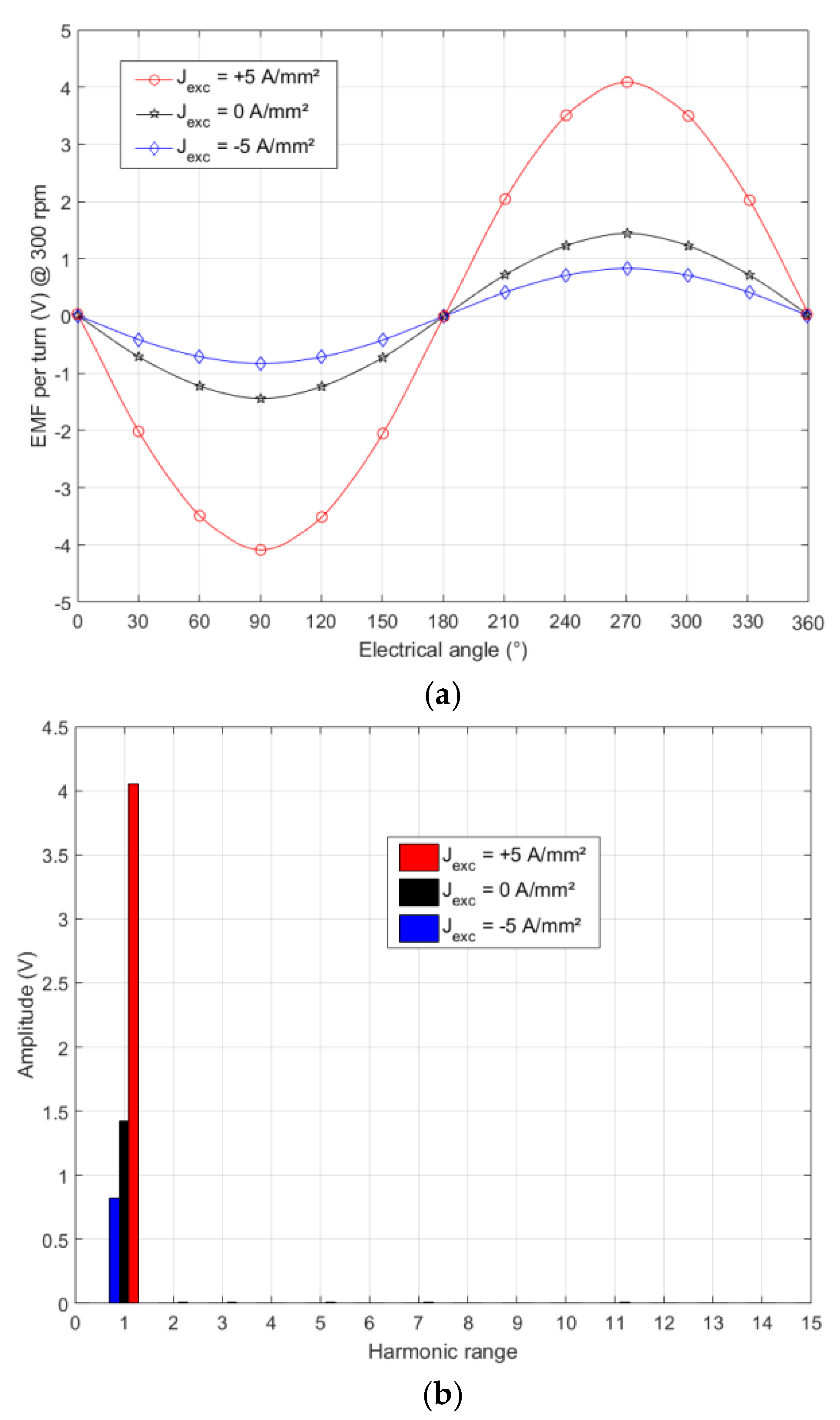
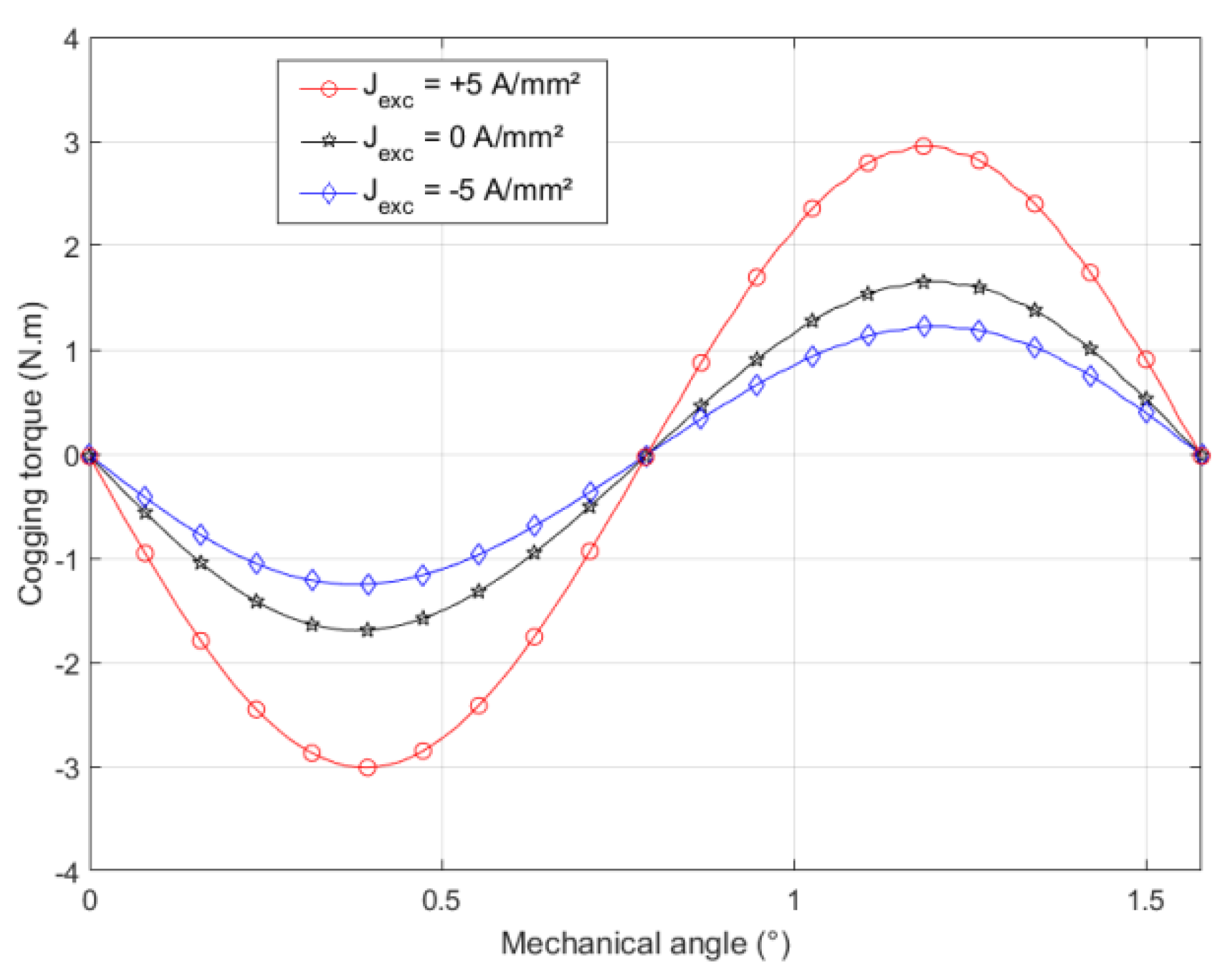
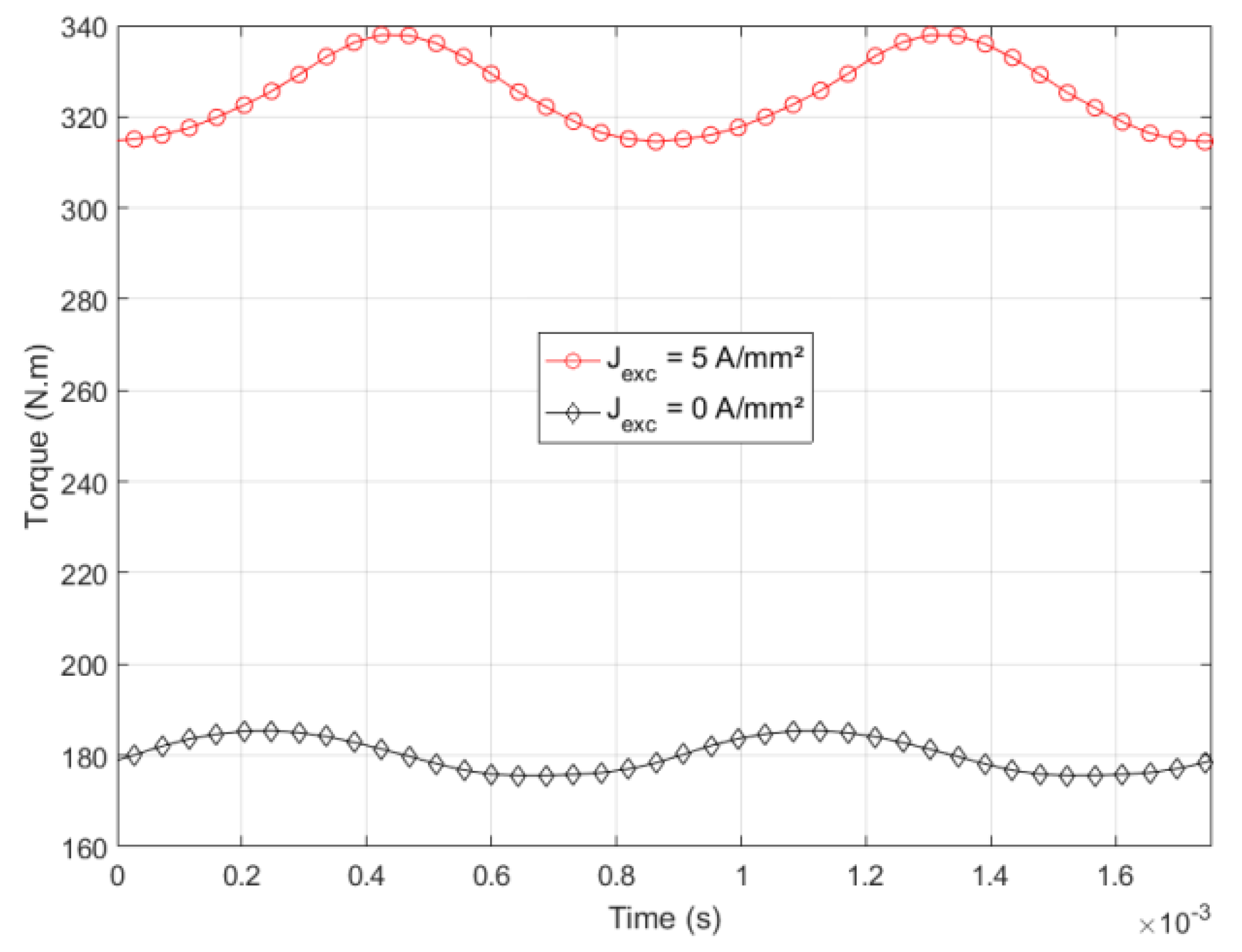
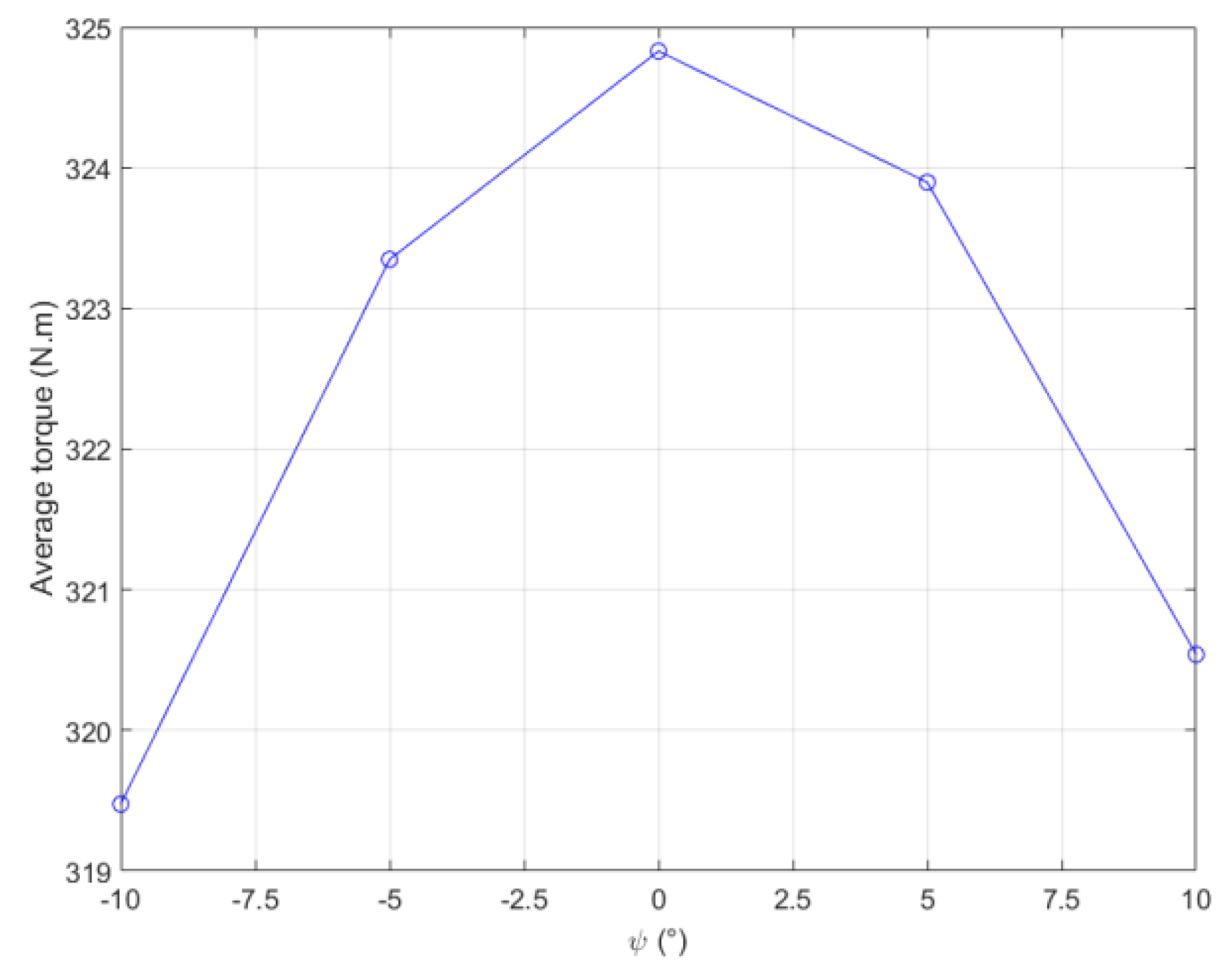
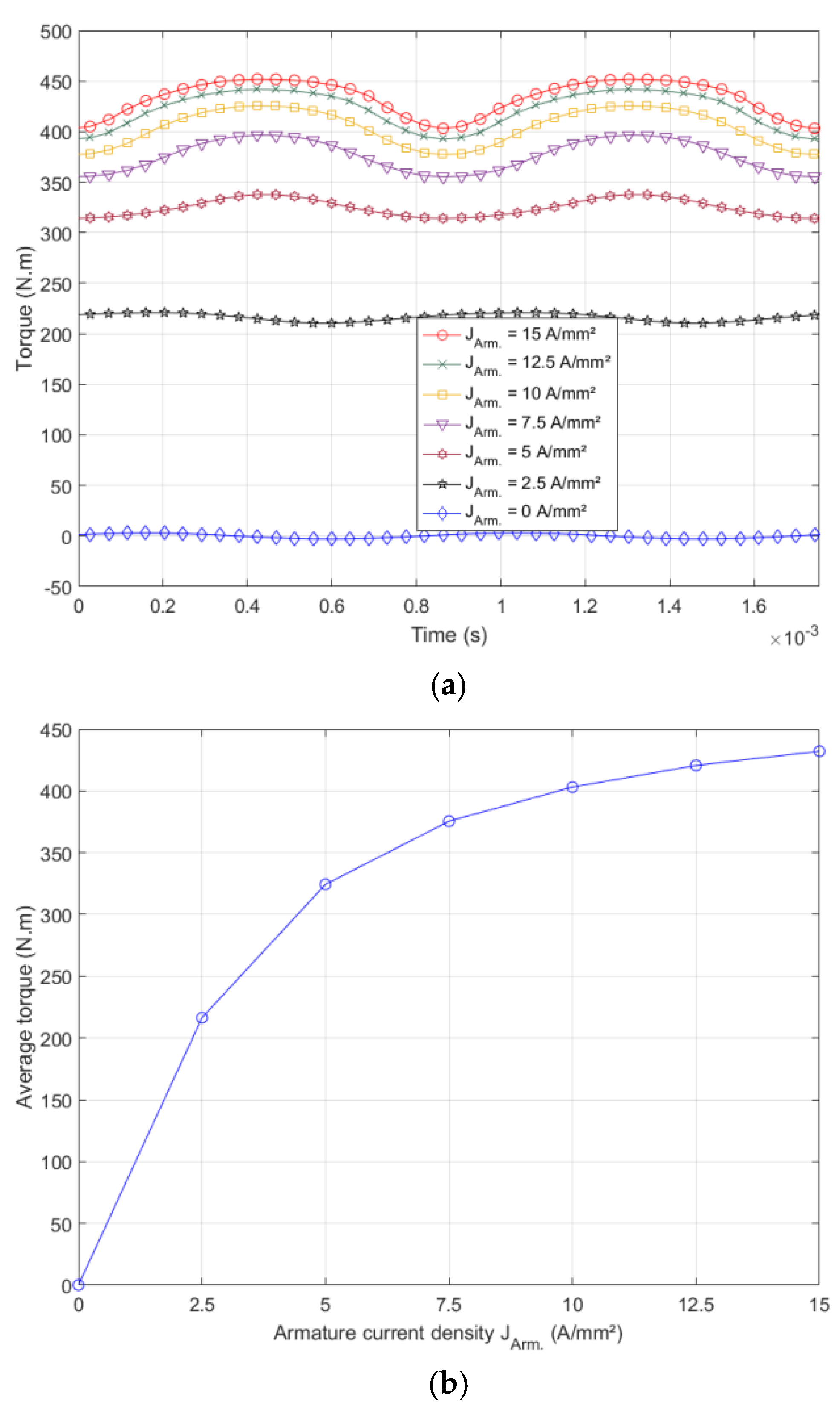
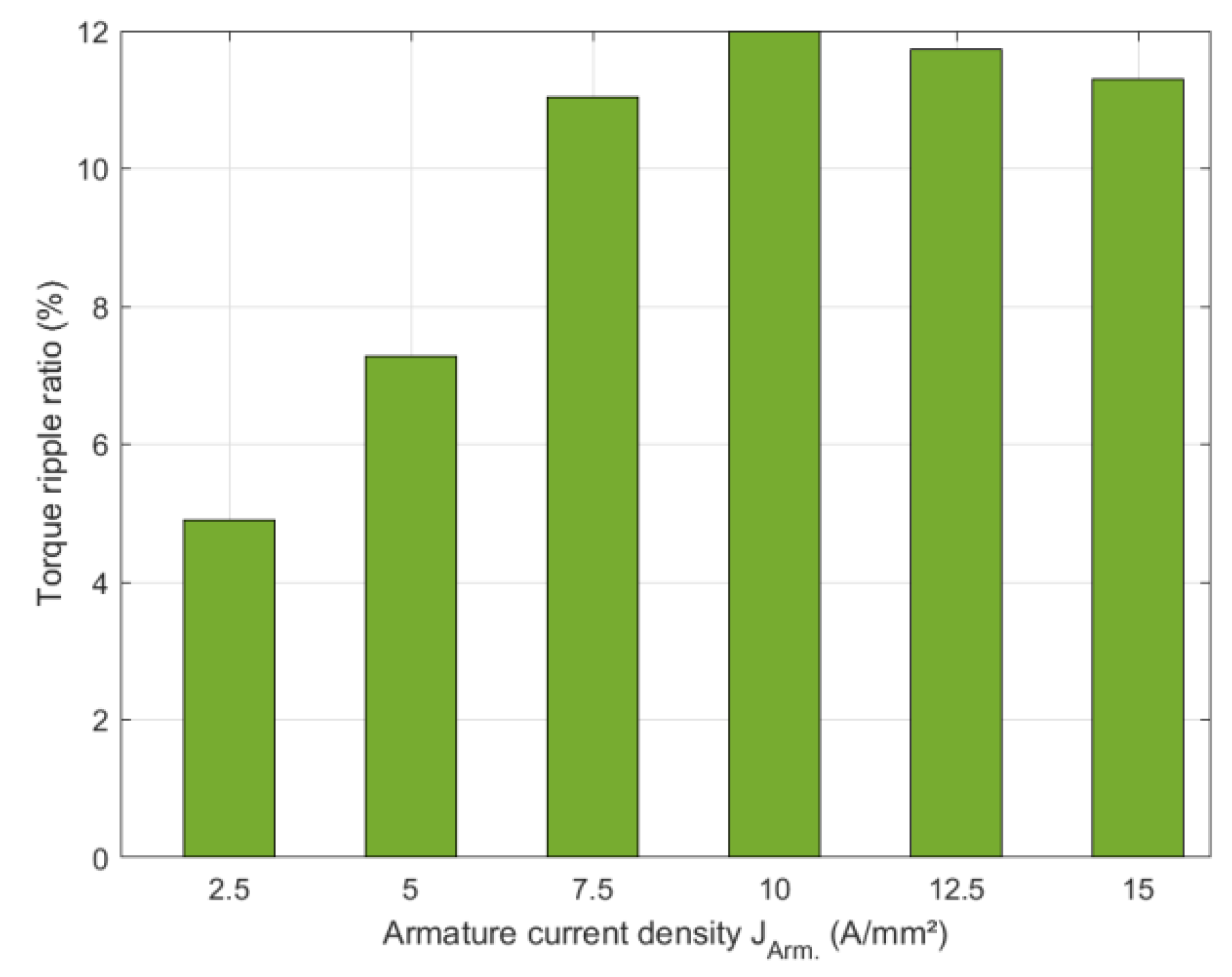
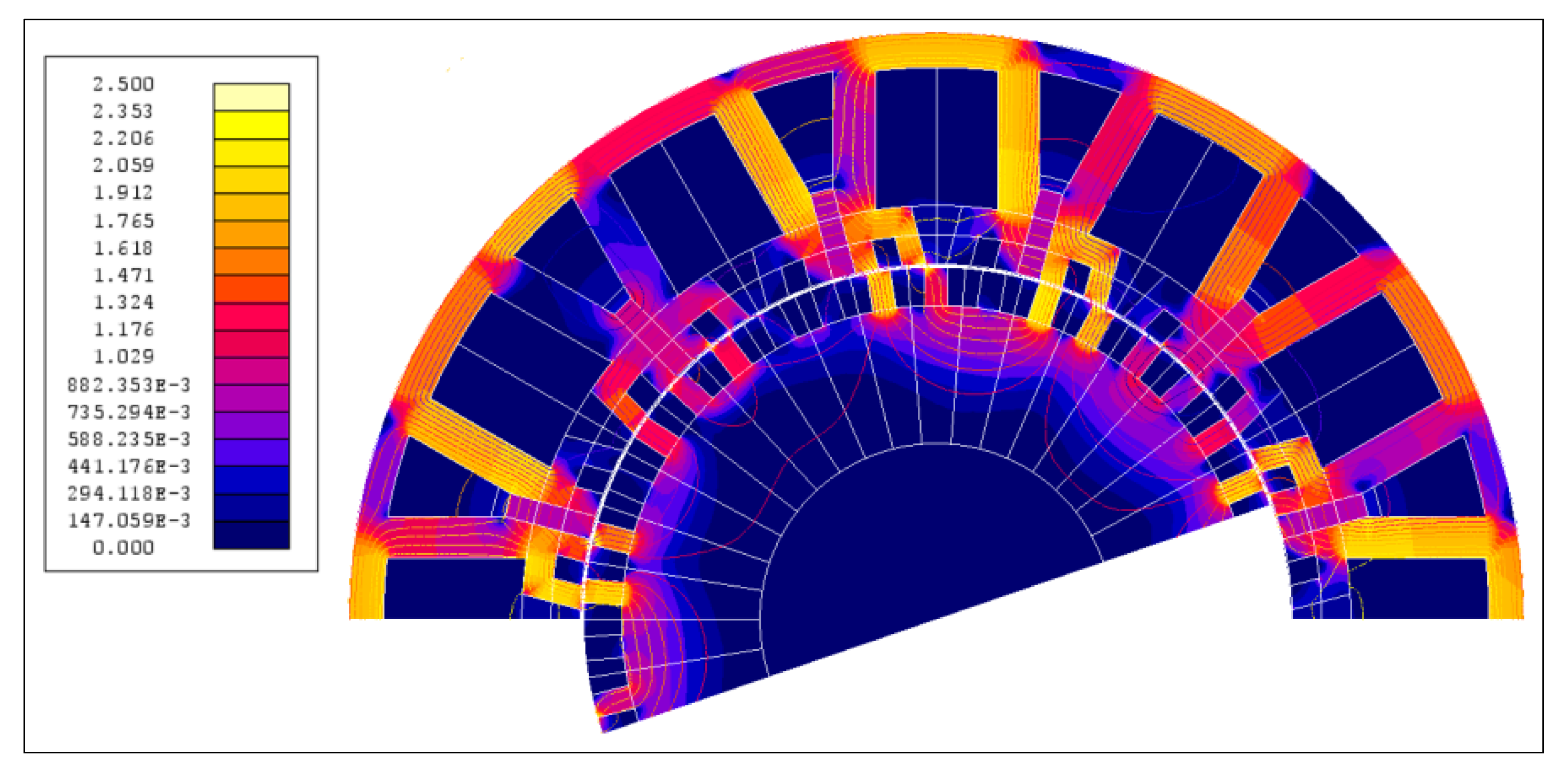
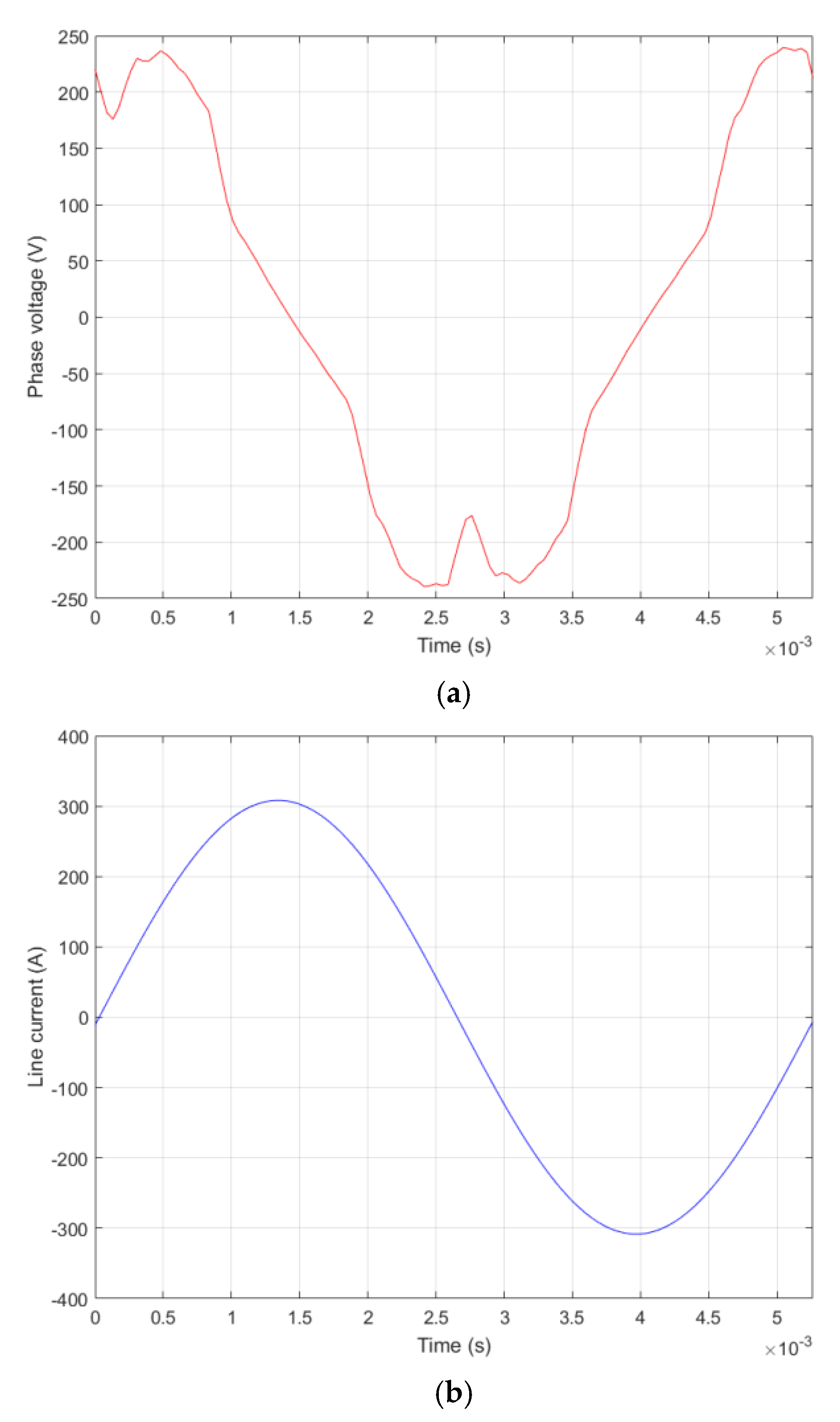
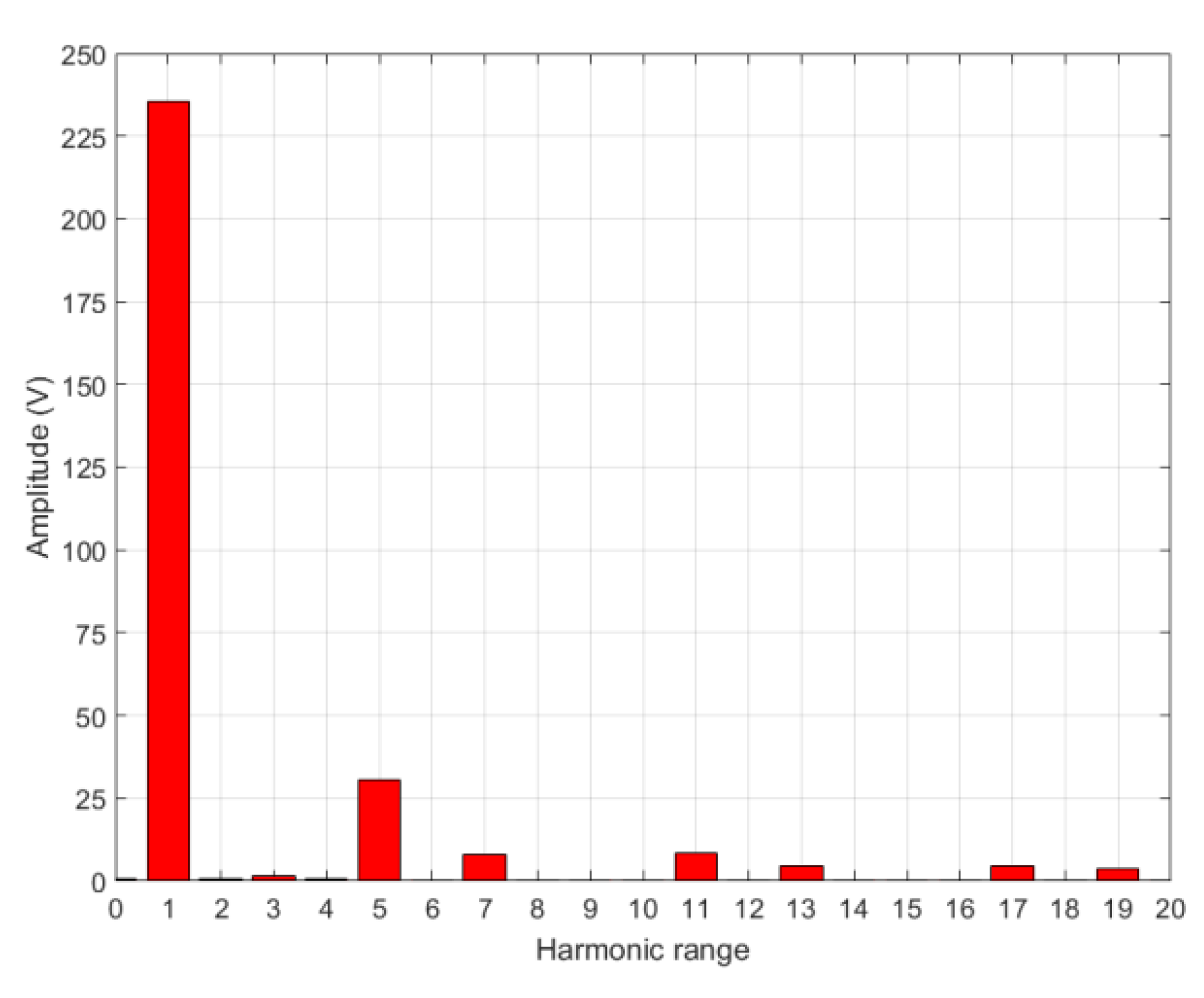
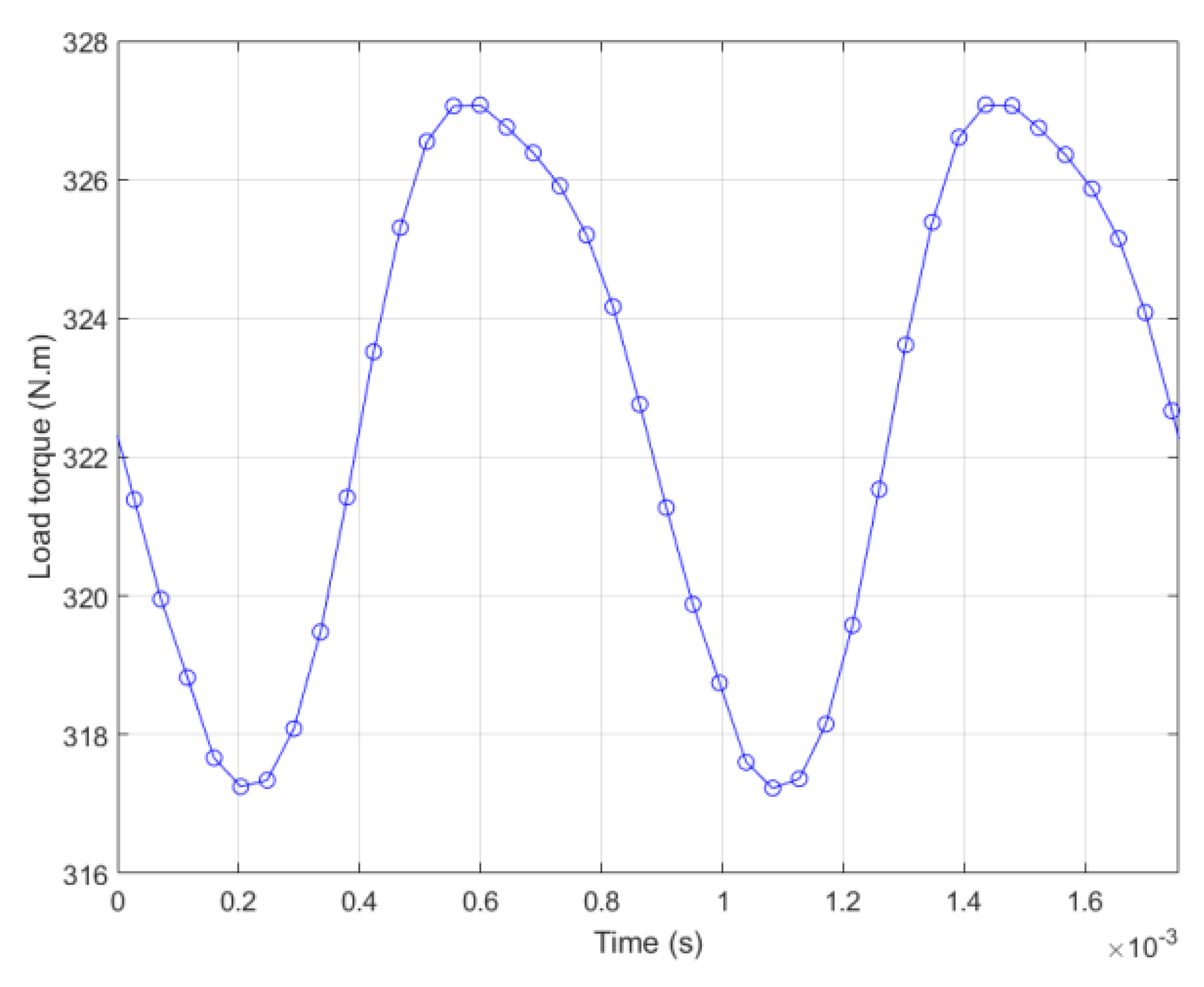

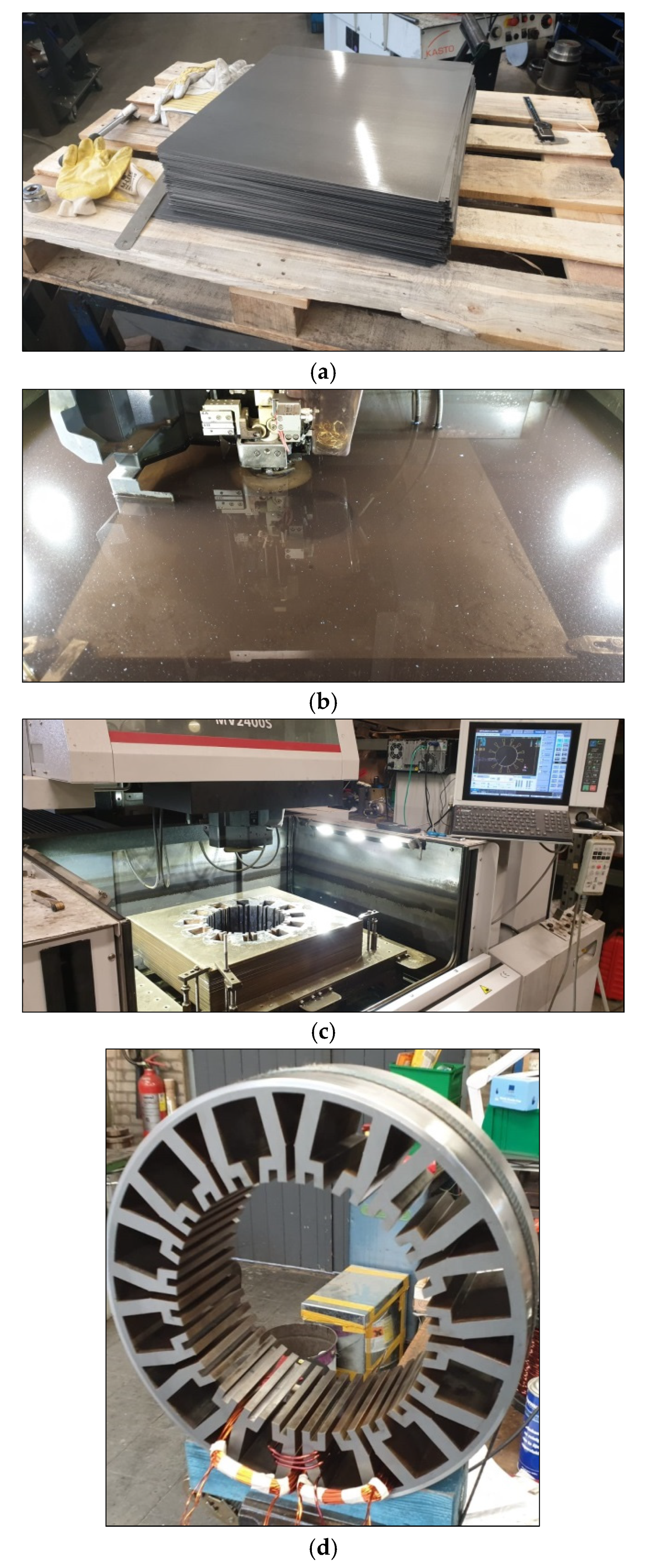
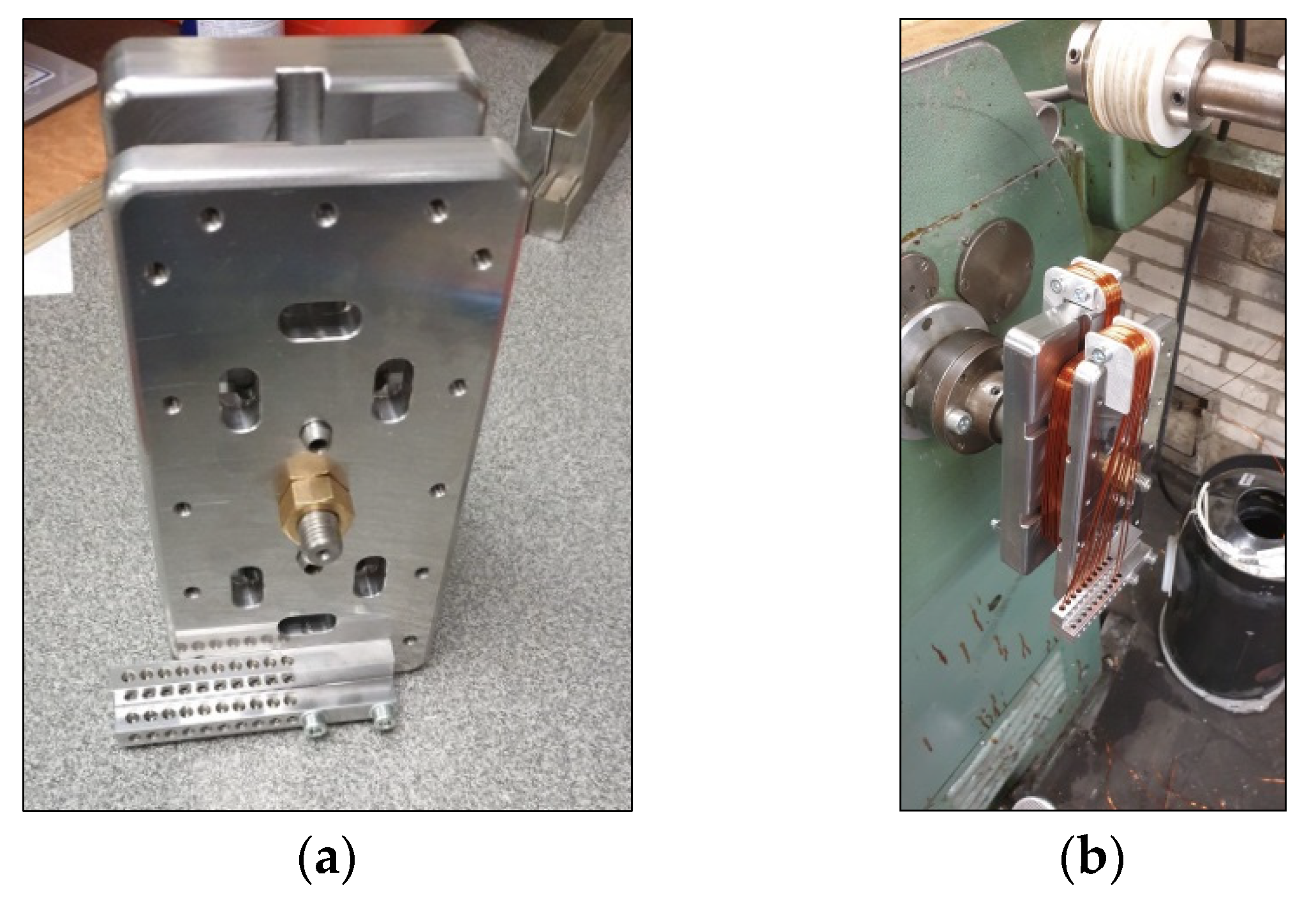
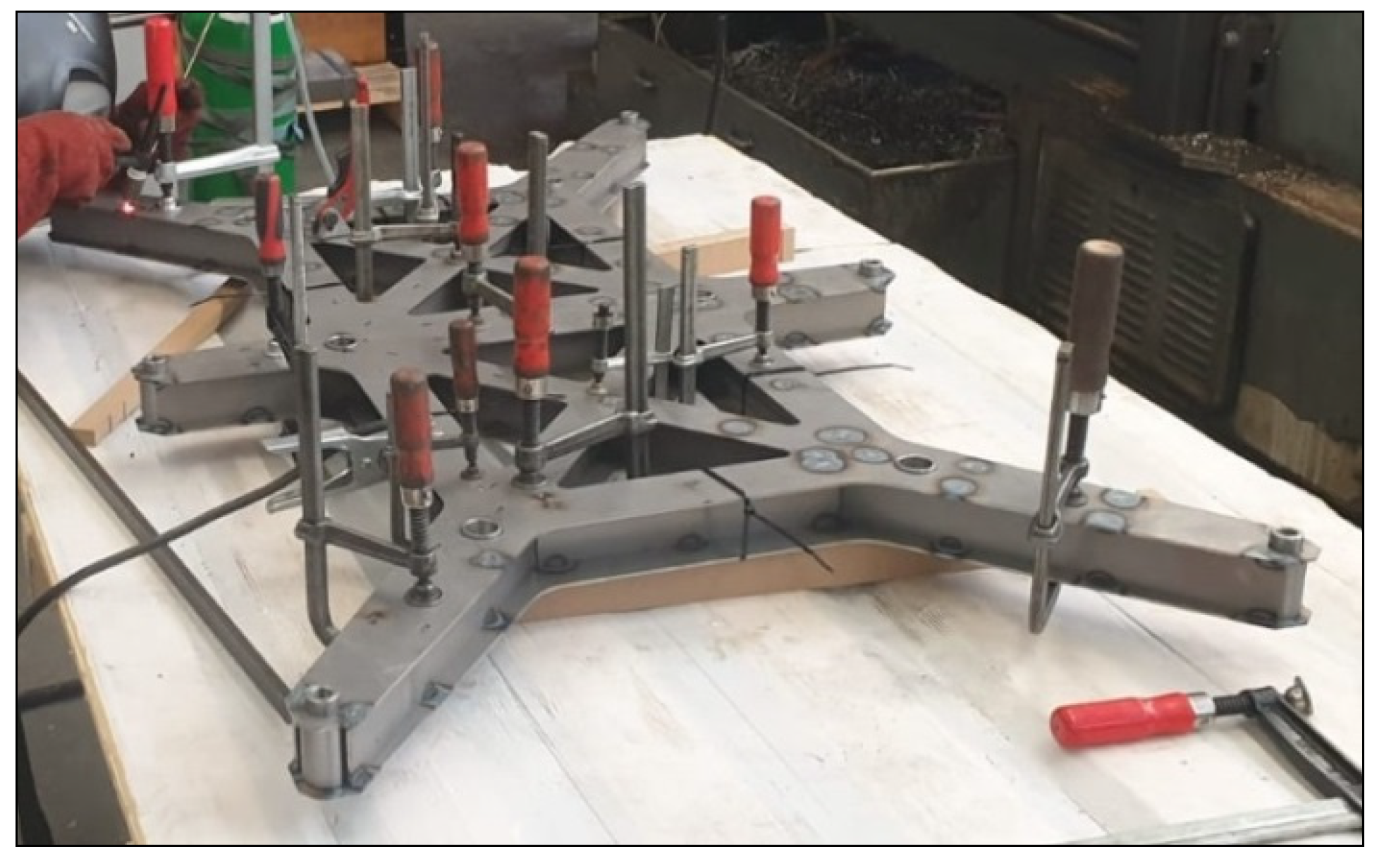
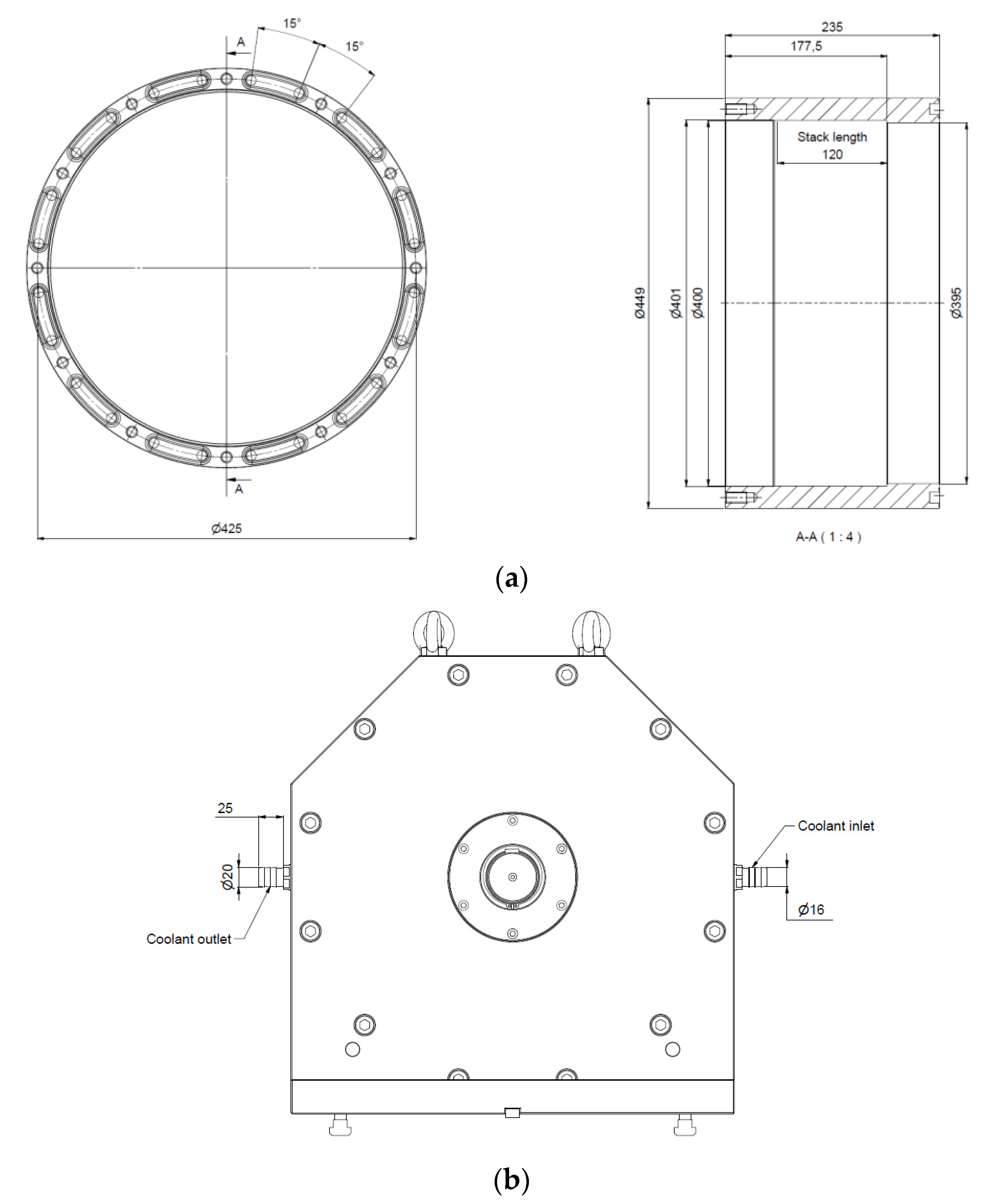
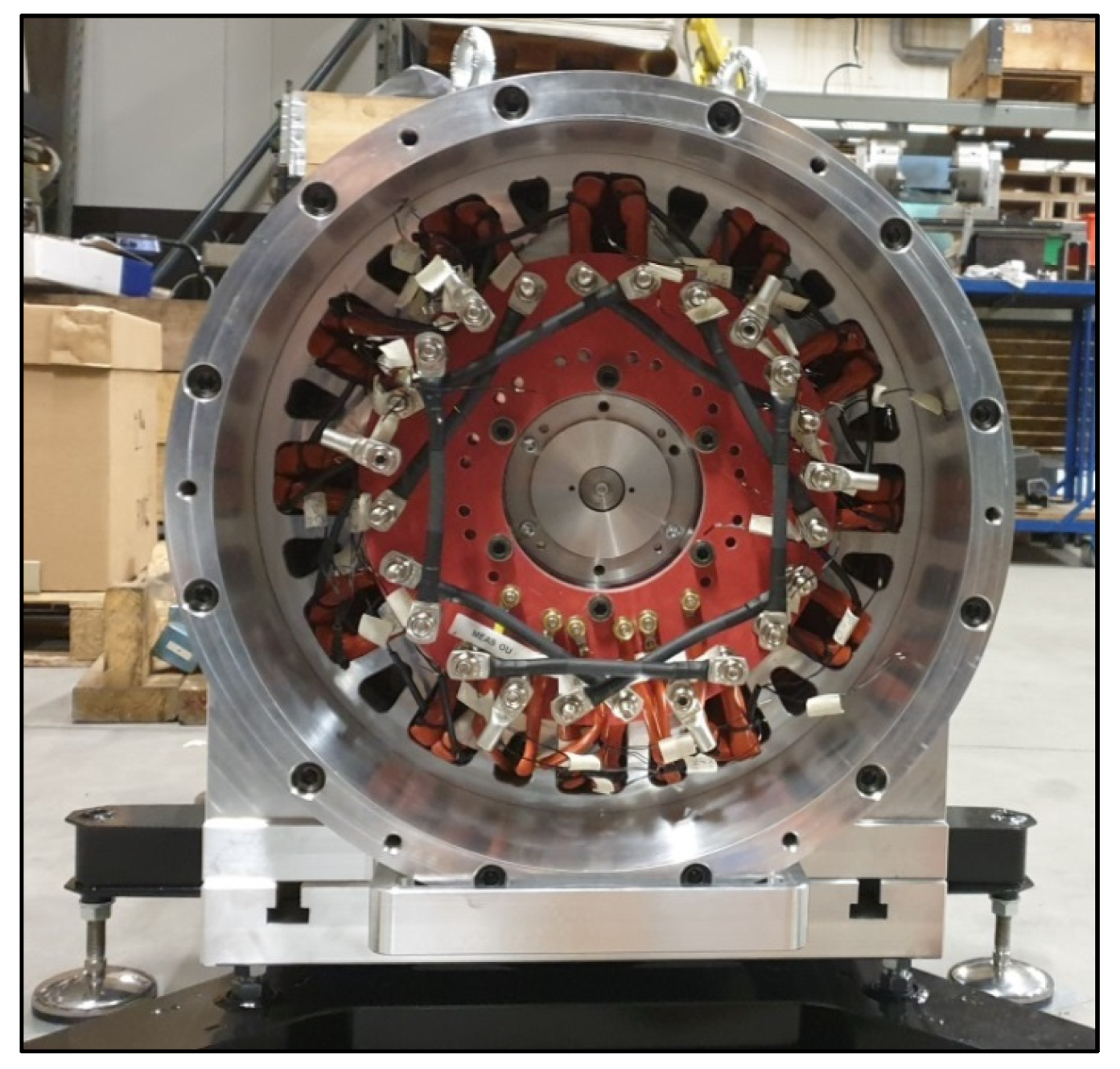
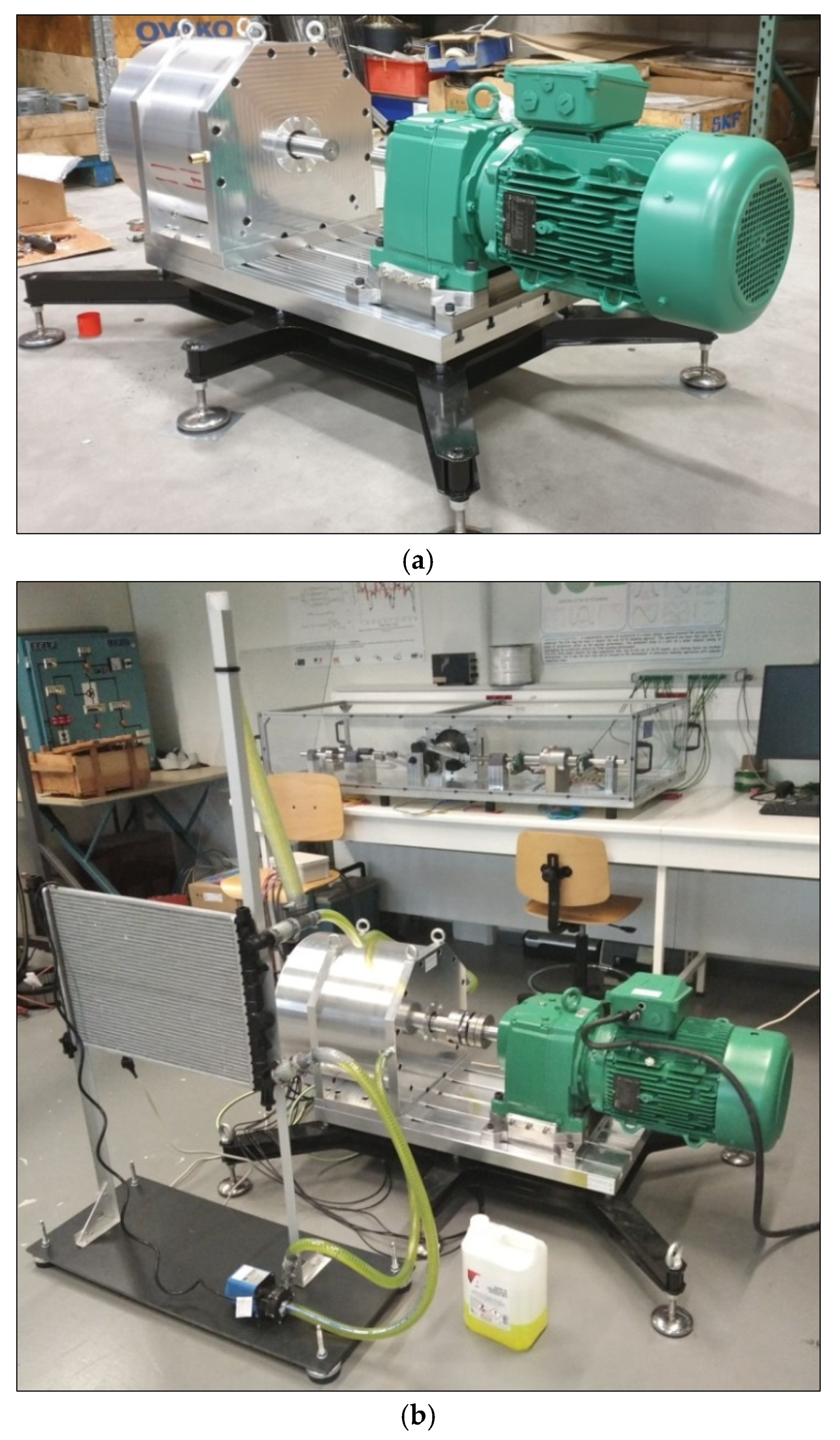

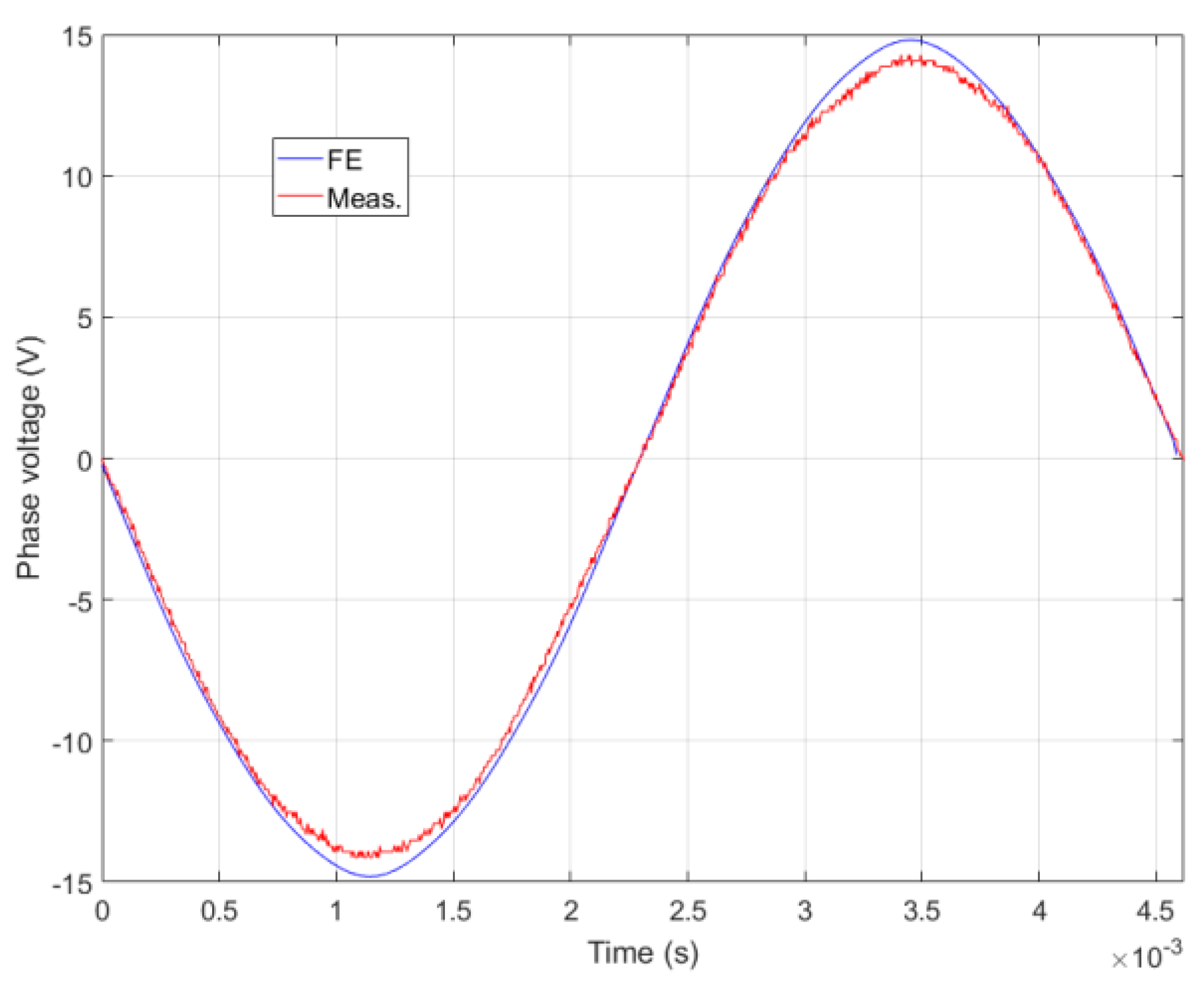

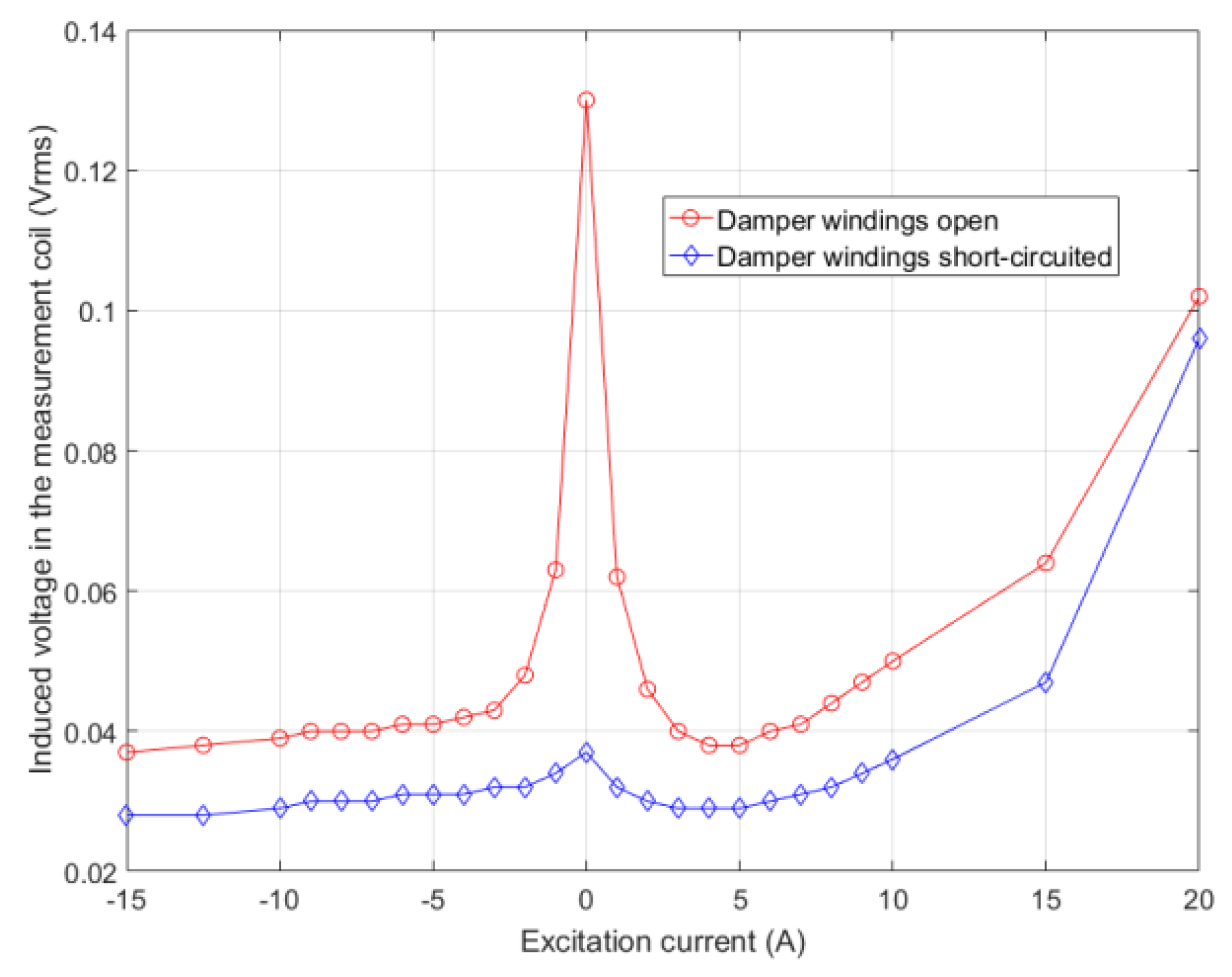

| Quantity | Value |
|---|---|
| Nominal power (kW) | 10 |
| Nominal rotation speed (rpm) | 300 |
| External radius (mm) | 200 |
| Active length (mm) | 120 |
| Air-gap thickness (mm) | 1 |
| PM characteristics (Br (T), μr) | 1.25, 1 |
| Number of turns of armature windings | 9 |
| Number of turns of excitation coil | 31 |
| Operation | F1 | F2 |
|---|---|---|
| Armature windings Joule loss (W) | 480 | 145 |
| Excitation coil Joule loss (W) | 165 | 659 |
| Iron loss (W) | 843 | 664 |
| PM eddy current loss (W) | 1261 | 41 |
| Total loss (PLoss) (W)/Efficiency η (%) | 2749/73 | 1509/85 |
| Quantity | Value | Quantity | Value |
|---|---|---|---|
| Nominal power (kW) | 10 | Mass of the stator iron core (kg) | 76.5 |
| Nominal speed (rpm) | 300 | Mass of the rotor iron core (kg) | 73.5 |
| External radius (mm) | 200 | Mass of the copper (Kg) | 128 |
| Rotor outer radius (mm) | 120 | Armature windings (AW) number of turns | 9 |
| Active length (mm) | 120 | Excitation coil (EC) number of turns | 31 |
| Air-gap thickness (mm) | 1 | Damping winding (DW) number of turns | 4 |
| Number of rotor teeth | 38 | AW resistance (at room temperature) (Ω) | 0.1 |
| PM type | NdFeB | EC resistance (at room temperature) (Ω) | 1.1 |
| Mass of the PM (kg) | 6.5 | DW resistance (at room temperature) (Ω) | 0.25 |
Publisher’s Note: MDPI stays neutral with regard to jurisdictional claims in published maps and institutional affiliations. |
© 2021 by the authors. Licensee MDPI, Basel, Switzerland. This article is an open access article distributed under the terms and conditions of the Creative Commons Attribution (CC BY) license (https://creativecommons.org/licenses/by/4.0/).
Share and Cite
Diab, H.; Amara, Y.; Hlioui, S.; Paulides, J.J.H. Design and Realization of a Hybrid Excited Flux Switching Vernier Machine for Renewable Energy Conversion. Energies 2021, 14, 6060. https://doi.org/10.3390/en14196060
Diab H, Amara Y, Hlioui S, Paulides JJH. Design and Realization of a Hybrid Excited Flux Switching Vernier Machine for Renewable Energy Conversion. Energies. 2021; 14(19):6060. https://doi.org/10.3390/en14196060
Chicago/Turabian StyleDiab, Haidar, Yacine Amara, Sami Hlioui, and Johannes J. H. Paulides. 2021. "Design and Realization of a Hybrid Excited Flux Switching Vernier Machine for Renewable Energy Conversion" Energies 14, no. 19: 6060. https://doi.org/10.3390/en14196060
APA StyleDiab, H., Amara, Y., Hlioui, S., & Paulides, J. J. H. (2021). Design and Realization of a Hybrid Excited Flux Switching Vernier Machine for Renewable Energy Conversion. Energies, 14(19), 6060. https://doi.org/10.3390/en14196060







